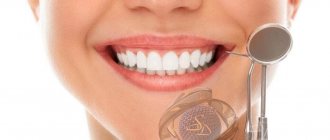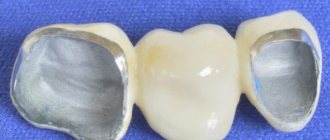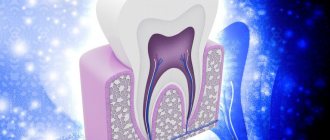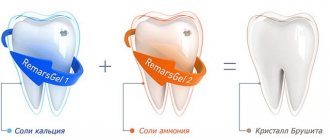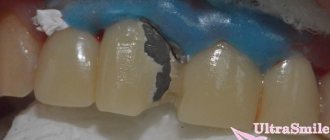Metal-ceramic crowns are a reliable, long-term way to restore teeth. Although cermet material is very durable, it is not eternal. The patient sometimes encounters cracks, abrasions, chips or scratches on the surface of the crown. Damage to ceramic cladding is caused by:
- High chewing load (too hard food);
- violation of the manufacturing technology of a crown or prosthesis;
- incompatibility of frame base and cladding materials;
- violation of installation technology (long prosthesis, incorrectly selected abutment teeth);
- bite problems;
- bruxism (teeth grinding).
Damage to the ceramic lining disrupts the aesthetics of the prosthetic structure and its functionality. But this is no reason to despair. The damaged surface can be restored, returning the crown to its original appearance. The main method of restoring a chipped crown without removing it is the restoration of metal ceramics with a light-curing composite.
Types of crowns
Metal-ceramic crowns differ in the metal alloy from which the frame is made, the manufacturing method, and service life. In most cases, an alloy of base metals (chromium-nickel, chromium-cobalt) is used to make the frame. They are durable, reliable, and not subject to deformation. This is a budget option that, with proper care, will last 8-10 years.
Often the frame is made of an alloy of gold with palladium, platinum, and silver. These are hypoallergenic materials that have an antibacterial effect, containing up to 80-90% gold. Ceramic-lined structures look natural, so they are perfect for installation in the smile area. Service life – up to 12-15 years.
When it comes to prosthetics on implants, the base of the crown is made of titanium. The material is compatible with body tissues, does not cause allergies, and eliminates the development of galvanic effect (galvanosis). Such structures will last 15 years or more.
According to manufacturing technology, metal-ceramic crowns can be cast or milled. Ceramic mass is applied layer by layer to the finished frame, made by any method, firing each subsequent layer. Modern dentistry has solved the problem of the “blue” strip around the gums, which made the installation of metal-ceramic structures on the front teeth undesirable. Today, crowns with shoulder mass are used - the manufacturing technology provides for a special ledge, which is also lined with ceramics to avoid oxidation of the metal upon contact with the gum. This makes the prosthesis aesthetic, allowing you to restore incisors and canines.
Can chipped dental crowns be repaired?
2 methods of crown restoration: which structures in principle need repair
One of the common problems that people who wear dentures face is damage to the dentures or a chipped crown. Typically, such defects appear on metal-ceramic models, so we will consider the reasons for such phenomena and options for repairing the prosthesis.
Material characteristics
Metal-ceramic columns are two-layer orthodontic structures, the frame of which is made of metal, and the front lining is made of ceramic. Typically, such dentures are used to restore a badly damaged tooth or if several need to be quickly restored. They are also used in the manufacture of bridge structures.
Metal-ceramic crowns are non-removable and therefore do not require special care and maintenance.
Causes of damage
Typically, chips on crowns occur infrequently. This prosthetic technology is one of the most reliable and durable, however, there are situations when damage does occur. There are several reasons:
- large chewing load. It usually occurs when eating solid foods;
- violation of the technology for installing or manufacturing a prosthesis;
- bruxism;
- incorrect prosthesis size;
- falling of a solid particle between the crown and tooth, etc.
In fact, even a medical error during impression taking and fitting can lead to the appearance of a defect.
However, metal-ceramic crowns can be repaired, which increases their service life and saves the owner from the need for replacement.
Methods of prosthesis restoration
Repair of metal-ceramic crowns is carried out using three different technologies, depending on the scale of the defect:
- Minor chips can be removed by polishing. It is important to note that as a result of processing, the structure may change shape, so this method of restoration is applicable only for dentures that are installed on distant teeth.
- Composite extension. This technology is the most common and allows you to restore even crowns with serious damage. Moreover, the structure is not removable. All manipulations are performed simply in the patient’s mouth.
In case of serious damage, the prosthesis is removed and simply replaced with a new one. In some cases, they resort to removing the structure to carry out repairs. However, this is an extreme measure, since it is not always possible to install it back.
Features of repair of zirconium crowns
This type of structure has been used in dental prosthetics relatively recently, and today they are the most durable and reliable in comparison with their analogues. It is virtually impossible for a zirconium crown to chip, eliminating the need for repairs.
Dental Health Predictions
Regardless of the technology for restoring a metal-ceramic crown, it is impossible to predict how long it will last. But it is quite possible to find out the approximate period of operation based on a number of signs:
- size of the lesion. If the chip is large or there are several damages, then the prosthesis will most likely collapse quickly, for this reason it is better not to waste time and money on restoration, but to immediately replace it;
- the basis. If it is made of metal, then it adheres to the composite worse than ceramics;
- bite. If it is incorrect, then this factor can again provoke a breakdown;
- non-compliance with recommendations for use and care;
- leaky connection, causing the structure to collapse.
Bridges with a large number of “teeth” are also at risk of breaking, so you should give preference to single dentures.
Restoration methods
Shallow cracks and abrasions are eliminated by polishing the ceramic surface. Small chips are restored using light-curing composites. This is the most common way to restore an orthopedic system without replacing it. Restoration of metal ceramics includes the following stages:
- The extension area is isolated from moisture;
- grind the chipped area to improve the adhesion of materials;
- after drying, a composite material is applied to the defect layer by layer, each layer is illuminated with a UV lamp;
- Upon completion of the extension, the area is ground and polished to give a natural shine, the appearance of a crown.
Repairing a metal-ceramic chip takes about 30 minutes. Restoration extends the life of the prosthesis, restores the original appearance, and returns the aesthetics and functionality of the dentition. However, repair of chips on metal ceramics is carried out without a guarantee, since there are many negative factors that affect the service life of the restoration.
If a metal-ceramic crown breaks off, there is no need to throw away the fragment. It is likely that the doctor will be able to use it to restore the integrity of the lining. In case of extensive damage, when a significant part of the metal is exposed, or chips of the lining of the contact surfaces, another option is required - replacing the damaged structure with a new one.
Restoration of metal ceramics after removal
Crown restoration is a complex job that requires professional skills. There is a serious risk of product destruction during removal. To perform this work you need special tools and devices.
If the broken fragment is preserved, it is fixed with medical glue. If there is no separated part, use the method of layer-by-layer application of the ceramic composition until the desired shape is obtained. The product is dried in a special oven using high temperature. Finally, turning and polishing are carried out. The method does not guarantee long-term use of the restored structure, even with high quality work performed.
How is a crown replaced?
Installation of a dental crown is a non-removable prosthetic method. This means that the patient cannot remove the structure on his own. This is done exclusively in a clinical setting. After the specialist has decided to replace the structure with a new one, in order to facilitate the removal of the damaged crown, it is carefully sawed or the cementing composition is destroyed with ultrasound. In this case, the crown can be removed without damaging it.
After removing the structure, the dentist assesses the condition of the supporting tooth and, if necessary, treats it. Upon completion of treatment and filling, repeated prosthetics are performed. That is, dental impressions are taken again, a prosthesis is made in the laboratory, and after fitting, the finished structure is fixed with cement.
The choice of material for a new dental crown depends on the clinical picture and the wishes of the patient. Often, when it is necessary to replace an old structure with a new one, the patient wants to improve the aesthetics by changing metal ceramics to solid ceramics or zirconium dioxide.
Why did the metal-ceramic crown break?
In fact, the carelessness and negligence of the patient is far from the primary reason for the chipping of metal-ceramics. The crown can also chip:
- If the metal alloy and the ceramic mass do not match in thermal expansion;
- If the patient suffers from bruxism (involuntary creaking and grinding of teeth);
- If some foreign object gets between the crown and the stump of the tooth;
- If the tooth was initially modeled incorrectly;
- If the ceramic veneer was fired at the wrong temperature;
- If there were holes or chips in the frame.
Food gets under the crown: what to do
We have already said above that if there is an unpleasant odor from under the crown or food gets under the crown, these symptoms indicate the process of decay of the tooth tissue (carious tissue damage). No amount of rinsing or application can stop this process, and therefore, if you want to try to save the tooth, you need to urgently contact an orthopedic dentist.
It is only necessary to clarify that sometimes the smell from under the crown can be associated with the formation and suppuration of periodontal pockets. In this case, one of the symptoms may be redness of the gums around the crown, or there may be purulent discharge from periodontal pockets. It must be said that the formation of pockets near the crown occurs quite often, which can be associated both with prosthetic errors and due to poor oral hygiene.
Prevention of cracks in crown enamel
The best preventive measures are a balanced diet and careful treatment of your teeth. You should not eat hot and cold foods at the same time. This alternation leads to cracking of the enamel.
To maintain dental health, it is recommended to take dietary supplements. For example, a complex of calcium citrate and vitamin D. When brushing your teeth, you should give preference to medium-hard brushes and non-abrasive pastes. After eating, it is advisable to use dental floss.
To preserve your dental health, you need to undergo a preventive examination at the clinic twice a year and listen to the recommendations of dentists.
Restoration of metal ceramics in the mouth
This option is the most popular. Performed in stages:
- The problem area is thoroughly dried;
- A diamond drill is used to roughen the surface for better adhesion of the ceramics to the composite;
- The surface is cleaned, impregnated with an acidic composition, washed and dried;
- Silane is applied to the chipped area, treated with a primer, and a special mass is applied in several layers until the desired shape is obtained;
- The resulting surface is treated with an adhesive and a finishing composite material;
- Sanded and polished.
From the outside, the crown will look perfect, but there is no guarantee of long-term use of the structure after such restoration. Currently, non-destructive methods for removing crowns with the least damage have been developed - ultrasound and compressed air. However, the experience and skill of the dentist is the guarantee that the prosthesis will be safely removed and will maintain its integrity for re-installation - and without the use of high technology.
Author:
Mayorov Andrey Mikhailovich
Specialization:
orthopedic dentistry, dental prosthetics, implant installation
Metal ceramics or zirconium?
Many patients wonder: what is better – zirconium crowns or metal-ceramics? Roughly speaking, both structures are metal-ceramic, but zirconium is a so-called “white” metal that does not shine through ceramics, as happens with ordinary metal. Therefore, today ceramic crowns on a zirconium frame are close in aesthetic qualities to all-ceramic crowns, but at the same time they have the same strength as metal-ceramics. However, the prices for such prostheses are higher than for metal-ceramic structures.

